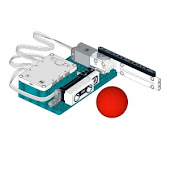LEGO MINDSTORMS Robot Inventor Activity Book by Daniele Benedettelli
Review by Sanjay and Arvind Seshan, PrimeLessons
The LEGO MINDSTORMS Robot Inventor Activity Book by ROBOTMAK3R, Daniele Benedettelli, provides an excellent project-based introduction to the new LEGO MINDSTORMS set launched last year.The book focuses on seven interactive models: a baseball batter, a paper gobbler, a pinball machine, an electric guitar, a transformer, a turtle, and an arcade game. Each chapter is devoted to one model. Clear building instructions and code are included for each model within a chapter. All his designs use sensors and incorporate interesting features of Robot Inventor. The result is seven fun and interactive projects to inspire builders of any age.
Benedettelli's book progresses from an easy first project to more complex building and coding techniques in subsequent projects. The baseball batter is a relatively simple build. The author uses it to introduce Robot Inventor parts and the new MINDSTORMS App. This provides an easy entry point for all readers. He takes time to explain the basics of the App in this chapter. An added bonus is that the Appendix provides a helpful programming block guide for those who want an overview of all the blocks in the App.Starting with the second project, the Gobbler, Benedettelli begins introducing more advanced programming concepts. What makes Benedettelli's book excellent is that he does a thorough job explaining the process. He includes pseudocode for the program, he explains new coding concepts, and walks the reader through the process of programming. Side "notes" provide added tips. By the end of the book, readers learn far more than basic coding. They learn to make their own my blocks, use variables, create lists, and much more.
Another good feature of his book is that he provides extensions to the basic code. Using "exercises", he asks the reader to adapt the program to add a new feature as an additional challenge. This is a great way of going beyond the book and engaging the readers to learn and do more. When showing the code, he also does an excellent job explaining how the blocks go into other blocks through the use of arrows and splitting the blocks up to show "their insides". This can be a challenge for Scratch-based coding, but Benedetti's images greatly simplify the process.The pinball machine in Chapter 7 offers a unique experience as it uses the Robot Inventor set's box as part of the building instructions. The build instructions for this game include the box, making it easy for the reader to understand how to assemble the final build. What is nice about this project is that the author builds upon an initial design, adding further instructions to enhance the realism of the project.The electric guitar is Benedettelli's signature model as he also created one using the LEGO MINDSTORMS EV3 in the past. His new version, made with the Robot Inventor set has a similar look and feel. Benedettelli's book offers detailed instructions on how to change the scale and notes, play chords, and more. The book also has a companion website where Benedettelli shares additional programs and tips to extend each project, including the electric guitar.The final chapter of the book is to inspire the reader to go beyond. The author offers some tips for programming Robot Inventor in Python and how to add hub-to-hub communication. He also encourages readers to share their work in the Robot Inventor Facebook Group that was founded by Marc-Andre Bazergui and managed by members of the ROBOTMAK3RS RLOC.
Through creative models and platforms to develop coding skills, the book provides something for everyone. Overall, Benedettelli's projects are a great way for anyone to dive into LEGO MINDSTORMS Robot Inventor.
One challenge regarding the book is that the Robot Inventor App is a moving target. LEGO tends to update features and add/change blocks relatively frequently in the early years of a product. While LEGO MINDSTORMS Robot Inventor Activity Book is accurate today, there may be new blocks and features that come out in the next year that are not in the book. Hopefully, Benedettelli will offer new editions to incorporate any future changes.
You can learn more about Daniele Benedettelli's book here.
About the Reviewers
Sanjay and Arvind have been writing lessons for MINDSTORMS and SPIKE Prime since 2014. They are the founders of EV3Lessons.com and PrimeLessons.org. They have taught 1 million students in 175 countries to build and program using LEGO Robotics platforms. They have also been technical editors for another MINDSTORMS-related book. Sanjay is currently a student at the Massachusetts Institute of Technology (MIT), where he studies Computer Science. Arvind is a high school student in Pittsburgh, PA.
Photo Credits: Amazon.com




